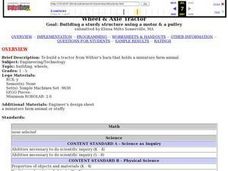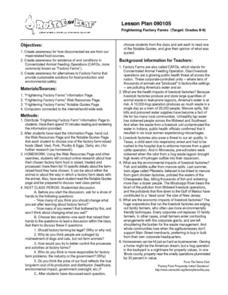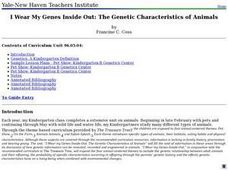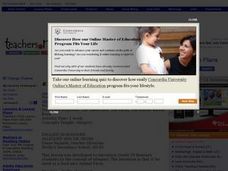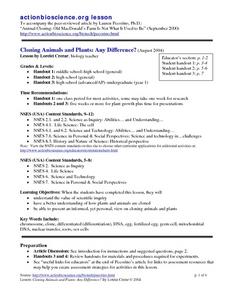Curated OER
Trading Off
Students explore how the North American Free Trade Agreement (NAFTA) has impacted the people and economies of North America and Mexico.
Curated OER
The Queen's Empire
Students conduct Internet research on a variety of ant species and their habitats. They have an opportunity to observe ants in their environment. Areas of interest might include ant identification, colony life, the ant life cycle, and...
Curated OER
Allegory in Painting
Students define allegory and discuss its use in visual arts. They identify and explain allegorical themes in a number of images.
Curated OER
Down with Dairy and the Food Pyramid
Students discuss food pyramid, name parts of pyramid, discuss dairy products and how they are beneficial to people, and participate in dairy taste testing.
Curated OER
Allegory in Painting
Young scholars define allegory and discuss its use in the visual arts, examine paintings from various time periods and identify allegorical themes in them, and explain what makes an image allegorical.
Curated OER
Scientists Breed See-Through Frogs
Students participate in a pre-reading activity, then read a news article about the breeding of transparent frogs. For this biology and current events lesson, the teacher introduces the article with a question and a vocabulary activity,...
Curated OER
Giraffe Riff Raff
Young scholars study the effects of wildlife conservation and relocation. For this conservation lesson students view video on the preservation of the giraffe populations and discuss the impact that humans have had on them.
Curated OER
Do we Really Need Wild Nature
Students research challenges with which modern biotechnology confronts wild nature. Students collect articles that relate to biotechnology and the environment. Students prepare a collaborative answer to the question, "Do we really need...
Curated OER
Wheel & Axle Tractor
Students design and build a tractor using LEGO materials. They write and draw their designs.
Curated OER
Thank You For the Food We Eat
Students explore where our food comes from. In this science lesson, students discuss how much of our food comes from animals. Students construct a mobile.
Curated OER
Frightening Factory Farms
Students discuss existence of and conditions on factory farms, and identify alternatives to factory farms that provide sustainable solutions for food production and environmental safety.
Curated OER
Mystery of the Malformed Frogs Lesson Plan
Students develop an understanding of how students and volunteers can make scientific observations that can aid conservation. They read the account of the Minnesota New Country School project by Ryan Fisher, Mystery of the Malformed...
Curated OER
Reindeer Ranch
In this Reindeer Ranch worksheet, pupils watch the video Reindeer Ranch by America's Heartland, fill in the blanks, and answer short answer questions about it. Students answer 7 questions.
Curated OER
They Don't Just Eat Grass
Students explore and examine different types of feed used for livestock. They discuss types of feed, the need for energy and health, and create graphs of food compared to categories. Students organize data and complete worksheets on...
Curated OER
Pyramid of Biomass
Pupils interpret data to demonstrate biomass and number pyramids. They use information to draw conclusions and examine an example of biological magnification.
Curated OER
Representing and Extending Patterns
Students explore repeating and growing patterns. In this patterns lesson, students describe patterns, explore changing patterns and match patterns. Students participate in online activities and read books that show patterns in...
Curated OER
I Wear My Genes Inside Out: The Genetic Characteristics of Animals
Students create mixed breed dogs using paper illustrations of various breeds. They label dogs created by students using the Genetics Center and discuss the aspects of genetics that affect the outcome of the various projects.
Richland County School District One
Incubating Quail Eggs
Students incubate quail eggs. In this biology instructional activity, students observe the development of the embryo, monitor, turn, weigh the eggs, and observe the hatching of the chicks. They identify the structures within a fertilized...
Curated OER
Enrichment Activities - "Mrs. Frisby and the Rats of NIMH"
Fifth graders read the novel "Mrs. Frisby and the Rats of NIMH." They discuss the various characters in the book, and the different types of conflict that take place within the book. They also research owls and rats to make comparisons...
Curated OER
The Allegorical Jonathan Livingston Seagull
Students write and discuss the definition of an allegory. They read the story, Jonathan Livingston Seagull, and analyze the style and allegorical elements within the story.
Curated OER
Allegory and Dr Seuss
Tenth graders read Dr. Seuss books to discover what allegory is. They investigate how Dr. Seuss studenT books are allegories of events in the real world and create timeline
Curated OER
Cloning Animals and Plants: Any Difference?
Students examine the process in which plants and animals are cloned. They compare and contrast the two procedures and determine if there is a difference. They share their views on cloning to the class.
Curated OER
Underwater Research
Students make transect and quadrat surveys using a provided worksheet in order to understand the techniques used to study coral reefs. Each type of survey is used to identify the species, diversity, and number of corals.
Curated OER
What's Organic?
Students define and discuss terms organic and synthetic, read article pertaining to organic agricultural practices in Oklahoma, complete worksheet, grow plants using both commercial and organic fertilizer, compare growth rates, and chart...
Other popular searches
- Farm Animals
- Animal Farm
- Farm Animals Theme
- Pictures of Farm Animals
- Farm Animal Math
- Farm Animal Powerpoint
- Animal Farm and Propaganda
- Animal Farm Lesson Plans
- Farm Animal Sounds
- Allegory Animal Farm
- Questions for Animal Farm
- Animal Farm George Orwell










